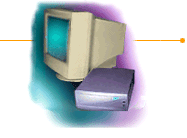|
|
 |
 |

|

|
Updated: February 18, 1998
|

|

|
|

|
|
 |
 |
 |
 |
The Network PC, or Net PC, is a new category of business PC intended to reduce
ownership costs through its advanced management capabilities while delivering the
power and versatility of traditional business PCs. Advanced system administration
features, including remote configuration and repair and the ability to "wake up"
systems for off-hours maintenance, give IT organizations greater centralized
management capabilities while retaining existing LAN infrastructures. Hard disk drives
give users the choice of running their Windows*-based business software and storing
data locally or on servers.
The Network PC System Design Guidelines specify a number of advanced
manageability features that enable easy, central administration. These include:
- Remote boot. The system can boot from a management server to
receive downloads or updated operating system software or
applications.
- Remote wake-up (Wake-On-LAN* technology). The system can be
turned on remotely for after-hours maintenance.
- DMI 2.0 support. System elements using the Desktop Management
Interface can be recognized and managed by industry-standard
management software.
- Instrumentation. System elements such as the baseboard, processor,
disks, mouse, keyboard, BIOS and video card can identify themselves
and provide management information to standards-based management
software.
- SMART hard drive. The disk can indicate when it may be about to fail,
giving the user time to avoid data loss.
- Hardware monitor. The system tracks various indicators of hardware
health, such as temperature or chassis open.
Net PCs are "managed" business PCs that cover the full range of price/performance,
including high-power systems based on Intel's Pentium® II processor. Products
based on the guidelines are emerging at a wide range of performance levels and price
points. The Net PC System Design Guidelines was developed by Intel, Microsoft*,
Compaq*, Dell* and Hewlett-Packard*.
|

|
 |
 |
 |
With its advanced management technologies, controlled configurations and sealed
case, the Net PC gives IT managers increased control over the distributed computing
environment. In addition, The Net PC offers a platform that is cost-effective to deploy,
manage and support, without sacrificing the desktop computing power, local storage
and application flexibility that make the PC a versatile and powerful tool for users. By
combining PC versatility and performance with centralized, network-based
manageability, the Net PC truly delivers a valuable new tool for business. The Net PC
is most appropriate for companies centralizing PC management and for those data-
and task-focused users who need no hardware expandability. For example, it is ideal
for information delivery, customer support, manufacturing, finance and training.
|

|
 |
 |
 |
The overall Net PC solution is spurring the adoption of manageability by driving
initiatives to increase base client management capability. By designing to the Net PC
System Design Guidelines OEMs will be able to integrate network-based remote
manageability features into their business desktop PC product lines.
|

|
 |
 |
 |
Intel's announcement of the Wired for Management (WfM) initiative in September 1996
generated considerable enthusiasm for managed PCs from OEMs, independent
workgroup and enterprise management software vendors, and end-users. Intel has
followed up the initial announcement with a series of events and tools delivered to the
industry in 1997. The following events have taken place this year to further enable
manageability in PCs and servers:
- Publication of the Wired for Management Baseline 1.0
- Publication of the Net PC System Design Guidelines
- Net PC Interoperability events (June and September)
- Net PC Introduction and Product Announcements
- Publication of the Wired for Management Baseline 1.1
- Publication of the Wired for Management tool kit
- Introduction of LANDesk® Client Manager v3.1
- Introduction of LANDesk® Management Suite 6
The third WfM Baseline and Net PC Interoperability test was
held on January 26, 1997. Over 20 OEMs, IHVs, and Manageability
vendors attended and tested their products showing that Manageable
PCs, Net PCs and mobile Pcs are available as well as the tools
to manage them (see the press release describing the event).
Intel also provided detailed technical training and tools to
further assist OEMs and IHVs in implementing the WfM
Baseline specification at the Intel Developer Forum held on
September 29, 1997. For more information on the IDF WfM
track. Intel will
host the next IDF on February 17, so don't miss the
WfM technical detials provided there.
Net PC systems began shipping from OEMs in the third quarter of 1997.
|

|
 |
 |
 |
Specifications have been available on both the WfM Baseline and the Net PC
since early 1997. Tools and training have been delivered to the industry.
Two interoperability events have been held showing the momentum behind WfM
baseline and Net PC and the arrival of product building blocks. Now is the
time for OEMs, IHVs, and Manageability software vendors to design and deliver
WfM-based and Net PC products so that businesses can take advantage of this
technology to reduce total cost of ownership.
|

|
 |
 |
 |
For more details on Net PCs, visit Intel's Net PC web site.
For more details on the Wired for Management
initiative from an IT perspective, visit Intel's Managed
PC web site.
For all the instructions, tools, and specifications for delivering Wired
for Management systems and products, visit the WfM Toolkit site.
|
 |
|
|
 |
 |
* Legal Information © 1998 Intel Corporation
|
|